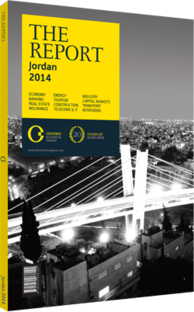Banking
The Company
Cairo Amman Bank was established in 1960 when Egypt’s Banque du Caire converted its branch in Amman to a public shareholding company. The bank operates in Jordan and Palestine with Jordan being its primary market. In 2013 about 82% of Cairo Amman Bank’s pre-tax income originated from its operations in Jordan. The bank is also one of Jordan’s most well-known mid-sized banks, with its main focus being on the retail sector. Specifically, the bank targets the employees of Jordan’s large public sector. In Palestine, however, the bank focuses on the corporate sector with the majority of its loans directed towards the Palestinian National Authority, telecoms, trading and manufacturing.
As a retail bank that primarily focuses on public sector employees, around 67% of gross loans at yearend 2013 were related to retail banking. The retail segment generated 50% of Cairo Amman Bank’s interest income in 2013. The company also has a very strong edge in this area, as it was the first Jordanian bank to penetrate this market.
Impressive Credit
With a 4.74% non-performing loans (NPL) ratio and a net NPL coverage ratio of 108% for the first quarter of 2014, the bank’s credit quality remains the best compared to its peer group. This strong asset quality reflects the bank’s deep understanding of the retail sector, high dependence on public sector employees, prudent risk management and low exposure to the high-risk small and medium-sized enterprises and corporate segments.
Cairo Amman Bank enjoys strong liquidity, with liquid assets such as government securities usually comprising more than 40% of total assets. The bank’s prudent liquidity management was evident in the 2008-10 period, during which it prioritised liquidity over profitability in order to face any possible pressures from the global economic downturn.
Improving Fiscal Position
The government’s IMF-supported fiscal reform programme, currently under implementation, along with foreign aid, should help the government curb the budget deficit in the medium term. This implies reduced financing needs by the government and lower interest rates on public debt instruments. Made up almost entirely of Treasury bills and government-backed bonds, the bank’s bond portfolio is expected to yield lower returns in the foreseeable future.
However, improving economic conditions are also set to boost the company’s loan book. Economic growth is estimated to accelerate to 3.5% in 2014, up from 2.8% in 2013, for the following reasons: an expansionary monetary policy, increased public spending and the influx of Syrian refugees. These factors combined should enhance economic growth and stimulate borrowing.
Well-Diversified Funding
Cairo Amman Bank’s total deposits represent around 90% of the banks’ non-equity funding. Customer deposits alone, which accounted for around 82% and 74% of total deposits and non-equity funding, respectively, at the end of the 2013 fiscal year funded more than 64% of the bank’s total assets. Government and public sector deposits accounted for 15% of customer deposits at the end of the 2013 fiscal year, while retail accounted for 63% of customer deposits. The deposit mix is skewed towards low-cost deposits, with current and savings account (CASA) funds comprising 53% of the bank’s customer deposits.
Cairo Amman Bank acquired a 10% stake in National Bank of Iraq, which is majority owned by the Capital Bank of Jordan. This reflects the bank’s intention to deploy some of its excess capital to expand in the region. The Palestine Telecommunications Company and Fursan Investment Group also bought stakes. The fierce competition on low-cost CASA deposits will ultimately increase Cairo Amman Bank’s cost of funds and in turn compress the interest rate spread. In addition, the medium size of the bank limits its pricing power as the bank competes with smaller players for funding and large banks for loan pricing.
You have reached the limit of premium articles you can view for free.
Choose from the options below to purchase print or digital editions of our Reports. You can also purchase a website subscription giving you unlimited access to all of our Reports online for 12 months.
If you have already purchased this Report or have a website subscription, please login to continue.

